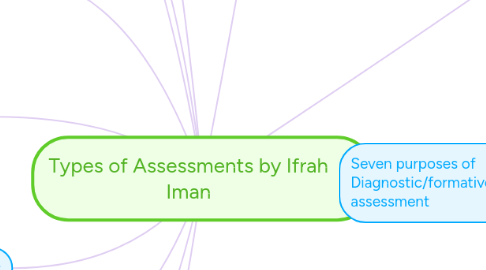Types of Assessments by Ifrah Iman
by Ifrah iman


1. Diagnostic
1.1. It is used to identify a student's needs, abilities, and the student's readiness to acquire the knowledge and skills outlined in the curriculum expectations.
2. Formative
2.1. The goal of summative assessment is to evaluate student learning at the end of an instructional unit by comparing it against some standard or benchmark.
3. Summative
3.1. Summative assessments are used to evaluate student learning, skill acquisition, and academic achievement at the conclusion of a defined instructional period.
4. Performance-based
4.1. Performance assessment, also known as alternative or authentic assessment, is a form of testing that requires students to perform a task rather than select an answer from a ready-made list.
5. Authentic
5.1. Authentic assessment is the measurement of "intellectual accomplishments that are worthwhile, significant, and meaningful," as compared to multiple choice standardized tests. Authentic assessment can be devised by the teacher, or in collaboration with the student by engaging student voice.
6. Self-assessment
6.1. A self assessment can reveal your personal attributes, values, skills, and interests, all of which are critical in helping you make informed career choices that are appropriate for you.
7. Peer assessment
7.1. Peer assessment, or self-assessment, is a process whereby students or their peers grade assignments or tests based on a teacher's benchmarks. The practice is employed to save teachers time and improve students' understanding of course materials as well as improve their metacognitive skills.
8. High-stakes
8.1. Any form of assessment can be used as a high-stakes test. Many times, an inexpensive multiple-choice test is chosen for convenience. A high-stakes assessment may also involve answering open-ended questions or a practical, hands-on section.
9. Portfolio
9.1. Portfolio assessment is an evaluation tool used to document student learning through a series of student-developed artifacts. Considered a form of authentic assessment, it offers an alternative or an addition to traditional methods of grading and high stakes exams.
10. Examples of standardized tests include: •The Comprehensive Test of Basic Skills •The Stanford Achievement Test •The ACT
11. Sources: https://www.google.ca/?gfe_rd=cr&ei=cp4BVr__IOyM8QengaawBw&gws_rd=ssl#q=Seven+purposes+of+Diagnostic%2Fformative%2FSummative+assessment
12. Seven purposes of Diagnostic/formative/Summative assessment
12.1. To assist student learning
12.2. To identify students strengths and weaknesses
12.3. Advanced
12.3.1. To identify students strengths and weakness.
12.3.1.1. To assess the effectiveness of a particular instructional strategy
12.3.2. To assess the effectiveness of a particular instructional strategy.
12.3.2.1. To assess and improve the effectiveness of curriculum programs
12.3.2.2. To assess and improve teaching effectiveness
12.3.2.3. To communicate with and involve COI
